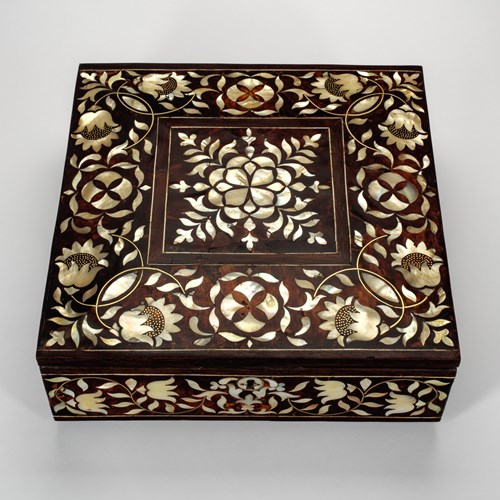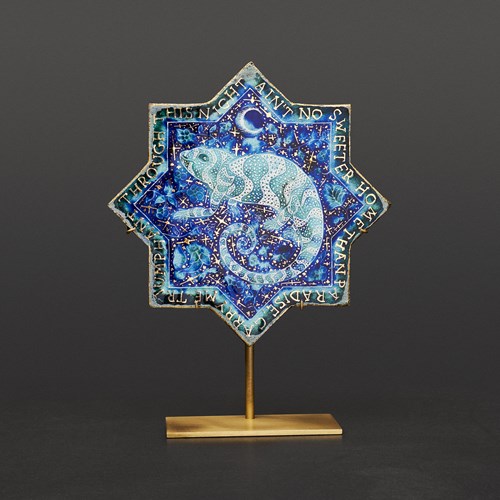Marketplace
Bidri Tray
This circular salver has a central design of two women standing on either side of a domed pavilion. One woman is bowing with hands folded while the other holds a vase in one hand and an unidentifiable object in the other. The person inside the pavilion is of unknown identity. The figure has long hair and sits in a manner that appears to be resting their hands on their knees. The figure’s legs seem to be bare, with a strip of cross-hatching running across the legs. There are trees, vines, and floral scrolls surrounding the pavilion and the two standing women.
A broad ring surrounds this central design and is richly decorated with the pattern of swirling waves of water. Within the water are depicted several distinct fish, storks, hamsa and stylised lotuses in bloom. These are all flora and fauna associated with water. It is thus possible the person in the central design is connected with riverine bodies. Running across the outer rim of the dish is a ring of trefoil motifs. The rim of the dish is decorated with tiny circular silver discs or dots, repeated in two concentric rings. This design is seen on a dish (76.1231 ME.10) and a ewer (accession no. 76.1226 ME.5)1 in the Jagdish and Kamla Mittal Museum of Indian Art as well as on a salver published in Susan Stronge. Bidri Ware: Inlaid Metalwork from India. London: Victoria & Albert Museum, 1985, p. 56. The swirling wave pattern with fish and other amphibious creatures with a dotted rim can be seen on a Bidri tray in the Salar Jang Museum, Hyderabad (inv. no. 56.229) and on a tray depicting calmer water and lotus blossoms in the Los Angeles County Museum of Art (accession no. M.89.19). Fish have been incorporated into Bidri design in many instances including the one mentioned earlier as well as a fish-shaped box in the Metropolitan Museum of Art (accession no. 19.135.15a, b) which is decorated with a similar style of whiskers and face as those in the present dish.
1 Mittal, Jagdish. Bidri Ware and Damascene Work in Jagdish & Kamla Mittal Museum of Indian Art. Hyderabad: 2011. pp. 58-59, pp. 68-69.
A broad ring surrounds this central design and is richly decorated with the pattern of swirling waves of water. Within the water are depicted several distinct fish, storks, hamsa and stylised lotuses in bloom. These are all flora and fauna associated with water. It is thus possible the person in the central design is connected with riverine bodies. Running across the outer rim of the dish is a ring of trefoil motifs. The rim of the dish is decorated with tiny circular silver discs or dots, repeated in two concentric rings. This design is seen on a dish (76.1231 ME.10) and a ewer (accession no. 76.1226 ME.5)1 in the Jagdish and Kamla Mittal Museum of Indian Art as well as on a salver published in Susan Stronge. Bidri Ware: Inlaid Metalwork from India. London: Victoria & Albert Museum, 1985, p. 56. The swirling wave pattern with fish and other amphibious creatures with a dotted rim can be seen on a Bidri tray in the Salar Jang Museum, Hyderabad (inv. no. 56.229) and on a tray depicting calmer water and lotus blossoms in the Los Angeles County Museum of Art (accession no. M.89.19). Fish have been incorporated into Bidri design in many instances including the one mentioned earlier as well as a fish-shaped box in the Metropolitan Museum of Art (accession no. 19.135.15a, b) which is decorated with a similar style of whiskers and face as those in the present dish.
1 Mittal, Jagdish. Bidri Ware and Damascene Work in Jagdish & Kamla Mittal Museum of Indian Art. Hyderabad: 2011. pp. 58-59, pp. 68-69.
More artworks from the Gallery





_T638447285695169442.jpg?width=500&height=500&mode=pad&scale=both&qlt=90&format=jpg)


